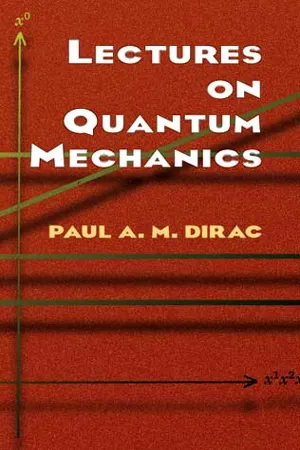
- 96 pages
- English
- ePUB (mobile friendly)
- Available on iOS & Android
Lectures on Quantum Mechanics
About this book
The author of this concise, brilliant series of lectures on mathematical methods in quantum mechanics was one of the shining intellects in the field, winning a Nobel prize in 1933 for his pioneering work in the quantum mechanics of the atom. Beyond that, he developed the transformation theory of quantum mechanics (which made it possible to calculate the statistical distribution of certain variables), was one of the major authors of the quantum theory of radiation, codiscovered the Fermi-Dirac statistics, and predicted the existence of the positron.
The four lectures in this book were delivered at Yeshiva University, New York, in 1964. The first, "The Hamiltonian Method," is an introduction to visualizing quantum theory through the use of classical mechanics. The remaining lectures build on that idea. "The Problem of Quantization" shows how one can start with a classical field theory and end up with a quantum field theory. In "Quantization on Curved Surfaces," Dirac examines the possibility of building a relativistic quantum theory on curved surfaces. He deduces that it is not possible, but it should be possible on flat surfaces. In the final lecture, "Quantization on Flat Surfaces," he concludes that "we can set up the basic equations for a quantum theory of the Born-Infeld electrodynamics agreeing with special relativity, but [not] with general relativity." Physics and chemistry students will find this book an invaluable addition to their libraries, as will anyone intrigued by the far-reaching and influential ideas of quantum mechanics.
Frequently asked questions
- Essential is ideal for learners and professionals who enjoy exploring a wide range of subjects. Access the Essential Library with 800,000+ trusted titles and best-sellers across business, personal growth, and the humanities. Includes unlimited reading time and Standard Read Aloud voice.
- Complete: Perfect for advanced learners and researchers needing full, unrestricted access. Unlock 1.4M+ books across hundreds of subjects, including academic and specialized titles. The Complete Plan also includes advanced features like Premium Read Aloud and Research Assistant.
Please note we cannot support devices running on iOS 13 and Android 7 or earlier. Learn more about using the app.
Information
Lecture No. 1
THE HAMILTONIAN METHOD

Table of contents
- Cover
- Title Page
- Copyright Page
- Contents
- 1. The Hamilton Method
- 2. The Problem of Quantization
- 3. Quantization on Curved Surfaces
- 4. Quantization on Flat Surfaces